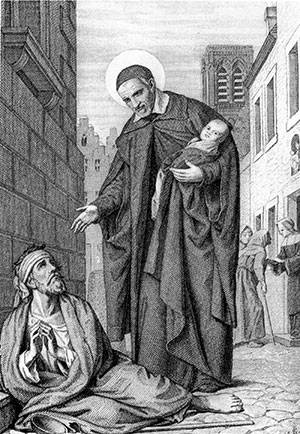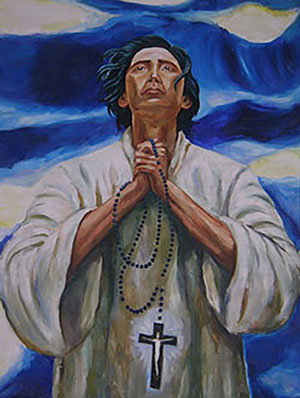Feast day: Sept. 27
 On Sept. 27, the Catholic Church remembers St. Vincent de Paul, the 17th century French priest known as the patron of Catholic charities for his apostolic work among the poor and marginalized.
On Sept. 27, the Catholic Church remembers St. Vincent de Paul, the 17th century French priest known as the patron of Catholic charities for his apostolic work among the poor and marginalized.
During a September 2010 Angelus address, then Pope Benedict XVI noted that St. Vincent “keenly perceived the strong contrast between the richest and the poorest of people,” and was “encouraged by the love of Christ” to “organize permanent forms of service” to provide for those in need.
The exact year of Vincent’s birth is not definitively known, but it has been placed between 1576 and 1581. Born to a poor family in southwest France, he showed his intellectual gifts from a young age, studying theology from around age 15. He received ordination as a priest in the year 1600, and worked as a tutor to students in Toulouse.
During a sea voyage in 1605, Vincent was seized by Turkish pirates and sold into slavery. His ordeal of captivity lasted until 1607, during which time the priest converted his owner to the Christian faith and escaped with him from Tunisia. Afterward, he spent time studying in Rome, and – in a striking reversal of fortune – served as an educator and spiritual guide to members of an upper-class French family.
Although Vincent had initially begun his priesthood with the intention of securing a life of leisure for himself, he underwent a change of heart after hearing the confession of a dying peasant. Moved with compassion for the poor, he began undertaking missions and founding institutions to help them both materially and spiritually. The one-time slave also ministered to convicts forced to serve in squalid conditions as rowers aboard galley ships.
Vincent established the Congregation of Priests of the Mission in 1625, as part of an effort to evangelize rural populations and foster vocations to remedy a priest shortage. Not long after this, he worked with the future St. Louise de Marillac to organize the Daughters of Charity, the first congregation of women religious whose consecrated life involved an extensive apostolate among the poor, the sick, and prisoners.
Under Louise’s direction, the order collected donations which Vincent distributed widely among the needy. These contributions went toward homes for abandoned children, a hospice for the elderly, and an immense complex where 40,000 poor people were given lodging and work. He was involved in various ways with all of these works, as well as with efforts to help refugees and to free those sold into slavery in foreign lands.
Though admired for these accomplishments during his lifetime, the priest maintained great personal humility, using his reputation and connections to help the poor and strengthen the Church.
Doctrinally, Vincent was a strong opponent of Jansenism, a theological heresy that denied the universality of God’s love and discouraged reception of the Eucharist. He was also involved in the reform of several religious orders within France.
St. Vincent de Paul died on Sept. 27, 1660, only months after the death of St. Louise de Marillac that previous March. Pope Clement XII canonized him in 1737. In 1835, the French scholar Blessed Frederic Ozanam took him as the inspiration and namesake for the Society of St. Vincent de Paul, a lay Catholic organization working for the relief of the poor.
— Catholic News Agency
Feast day: Sept. 28
 St. Lorenzo Ruiz was born around the year 1600 in Binondo, Manila, in the Philippines. He was the son of a Chinese father and a Filipino mother. Both were Christians and took care to raise Lorenzo as a Catholic. He served happily in his parish church as an altar boy and calligrapher.
St. Lorenzo Ruiz was born around the year 1600 in Binondo, Manila, in the Philippines. He was the son of a Chinese father and a Filipino mother. Both were Christians and took care to raise Lorenzo as a Catholic. He served happily in his parish church as an altar boy and calligrapher.
As a young man, Lorenzo joined the Dominican Confraternity of the Most Holy Rosary. Later, he married a woman named Rosario and the happy couple had three children, two sons and one daughter. By all accounts, the family was ordinary and happy.
In 1636, Lorenzo was accused of murder, allegedly having killed a Spaniard. However, to protect his safety at the time, he fled home and found refuge on board a ship with three Dominican priests and a leper. There are no details of this alleged crime other than a journal entry by two Dominican priests, that he joined their group to escape possible arrest. The ship departed the Philippines on June 10, 1636, bound for Okinawa.
A shock awaited the passengers when they arrived in Japan. At the time of their arrival, the rulers of Japan, the Tokugawa Shogunate, were persecuting Christians. Prior to this persecution, the Christian population of Japan was thought to number 50,000 souls.
Lorenzo was arrested by Japanese officials for the crime of being a Christian and ordered to recant his faith. When he refused, he was imprisoned for two years. On Sept. 27, 1637, Lorenzo and his companions were taken to Nagasaki to be tortured and killed if they would not recant their faith.
Lorenzo and his companions were tortured by water, which was forced into their mouths and down their throats and out their noses and ears. Despite the painful torture, the men refused to do so.
Following this, Lorenzo was hanged upside down, with a rope around his ankles. This method of torture was known as tsurushi, or “gallows and pit.” The torture forces a person to be hanged upside down with a gash cut in their forehead to prevent too much blood from gathering in the head. The gash also causes the victim to bleed to death over an extended period of time.
Those who have survived the torture have said it is unbearable. One hand is left free so the victim can offer an agreed symbol that will represent their desire to recant their faith. Those few who recant are spared and allowed to live. But few people ever recanted – choosing instead to die for their faith.
Lorenzo refused to recant. According to the record of his death, his last words were, “I am a Catholic and wholeheartedly do accept death for God. Had I a thousand lives, all these to Him I shall offer. Do with me as you please.”
His traveling companions were also all killed, steadfast until the end.
Lorenzo was beatified by Pope John Paul II on Feb. 18, 1981. The beatification ceremony was held in the Philippines – the first beatification ceremony ever held outside the Vatican.
A miracle attributed to his intercession occurred in 1983. A 2-year-old girl, Alegria Policarpio who had suffered from hydrocephaly since birth, was miraculously cured.
His canonization took place at the Vatican on Oct.18, 1987.
St. Lorenzo Ruiz is the patron saint of Filipino youth, the Philippines, people working overseas, and altar servers.
— Source: www.catholic.org

